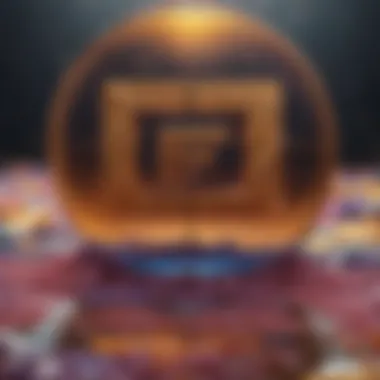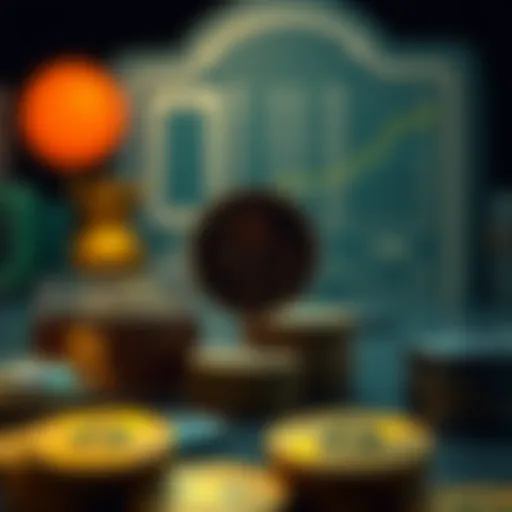Top NFT Minting Platforms: A Comprehensive Guide


Intro
The rise of Non-Fungible Tokens (NFTs) has reshaped the digital landscape, giving creators and collectors a unique way to engage with art, music, and moments. As the gallery wall moves from physical to virtual, the challenge becomes how to effectively mint these digital assets. With myriad platforms available, each with its distinct features and constraints, it can feel like searching for a needle in a haystack.
For those looking to embark on their NFT minting journey, understanding the platforms available is crucial. This article will shed light on various popular NFT minting platforms, breaking down what they offer, the fees associated, and how user-friendly they are. We aim not just to inform but to empower, providing insights that can guide you to the platform that best aligns with your creative vision and business objectives.
Intro to NFT Minting
As the digital world rapidly evolves, NFTs, or Non-Fungible Tokens, have emerged as a significant element within the online economy. This section serves as a gateway to understanding the mechanics of NFT minting, a process that lays the groundwork for creators and collectors alike. By diving into the intricacies of this practice, we recognize both its impact on the digital art landscape and its potential as a lucrative investment vehicle.
Defining NFTs
NFTs can be thought of as unique tokens on a blockchain that signify ownership of specific digital assets. Unlike cryptocurrencies such as Bitcoin or Ethereum, which are fungible and interchangeable, NFTs are unique or exist in limited quantities. Each NFT has distinctive information or attributes that set it apart, akin to owning a rare painting or a limited-edition sneaker.
This uniqueness is what gives NFTs their profound value. For instance, consider an artist who creates a digital painting. When they mint this painting into an NFT, it transforms into a certified piece of ownership. The NFT contains metadata confirming authenticity and provenance – crucial details that assure buyers they are acquiring something genuinely exclusive.
The Importance of Minting
Minting NFTs is one of the pivotal processes in the world of digital assets. It involves creating a token on the blockchain that verifies ownership of a digital item. But why is this so crucial?
- Ownership and Provenance: Minting not only establishes who owns the digital asset but also what its history is, reducing issues like counterfeiting.
- Access to Marketplaces: Most NFT marketplaces require assets to be minted before they can be sold or traded. It’s your golden ticket to the bustling marketplace where buyers and enthusiasts interact.
- Community Building: Minting an NFT often attracts a support community around the creator, which can lead to future collaborations and increases the artist’s visibility.
In summary, an understanding of NFT minting is indispensable. It’s the starting point for creators aiming to dabble in this space, providing them with the tools to monetize their digital creations effectively. Knowing how to navigate this process not only benefits artists but opens doors for collectors and investors who seek unique digital assets that are locked away on the blockchain.
Essential Criteria for Choosing an NFT Minting Platform
When it comes to minting Non-Fungible Tokens (NFTs), choosing the right platform can feel a bit like looking for diamonds in the rough. There's a plethora of platforms out there, each offering its own unique features and functionalities. This section aims to enumerate the essential criteria one should consider while choosing a minting platform for NFTs. Understanding these elements can significantly impact an NFT creator's journey, affecting not just the cost but also usability, security, and community interaction.
Cost Considerations
Cost is often the elephant in the room when discussing NFT minting platforms. The fees associated with minting NFTs can vary widely, depending on the platform and the blockchain network it utilizes. Ethereum-based platforms, for instance, might hit your wallet harder due to high gas fees, especially during peak network congestion. However, cheaper alternatives exist. Platforms like Tezos or Solana are known for their lower transaction fees.
It's crucial to closely scrutinize the fee structures before committing. Some platforms charge a flat fee for minting, while others implement a percentage of the sale price. Always be on the lookout for hidden costs that may not be apparent at first glance. If you’re an artist attempting to break into the NFT space, make sure that platform fees won’t eat away at your hard-earned profits.
User Interface and Experience
Next up, let’s chat about user interface and experience. A platform with a clunky interface can turn the minting experience from a creative endeavor into a tedious task. You want a platform that feels intuitive right from the get-go. OpenSea, for example, offers a user-friendly experience, with clearly defined sections that guide you through the minting process.
On the flip side, some platforms might overload you with unnecessary features that complicate a simple task. The goal here is to find a balance—look for platforms that allow you to navigate easily while providing all the necessary tools for minting and managing your NFTs.
Security Features
Security is paramount in the digital landscape, especially in the world of NFTs where high-value transactions occur. Knowing that your assets are secure gives peace of mind to creators. When exploring platforms, look closely at the security features they offer. For instance, Immutable X boasts a strong emphasis on security while providing a quicker and more efficient minting process.
"The best security can be negated by simple oversights—always enable two-factor authentication if available."
Make sure to check reviews and user feedback regarding security incidents or any vulnerabilities that have been reported. A platform with a proven track record around your assets' security will help you sleep easier at night.
Community and Support
Last, but certainly not least, let's not overlook the community aspect. The NFT space is not just about individual transactions; it's about building relationships. Platforms that foster vibrant communities can provide invaluable support, insights, and networking opportunities. For instance, platforms like Rarible actively engage with their user base to improve features while encouraging interaction among artists and collectors.
Good customer support can also be a lifesaver if you run into hiccups during the minting process. Choose a platform with responsive support channels, like live chat or detailed, user-friendly guides. A supportive community and efficient customer service can make a world of difference in your NFT journey.
Key Platforms for Minting NFTs


In the sprawling digital landscape, the importance of selecting the right platform for minting NFTs cannot be overstated. Each platform comes with its own unique traits, fee structures, and interfaces, which can significantly impact the user experience. By understanding the key platforms available, creators can make informed choices tailored to their specific needs. The following sections dive into the most prominent platforms, dissecting their strengths and weaknesses.
Ethereum-based Platforms
Ethereum has long been the leading player in the NFT space, thanks to its smart contract capabilities and widespread adoption. It offers various platforms where creators can turn their digital works into NFT assets.
OpenSea
OpenSea is often seen as the Uber of NFT marketplaces. Its user-friendly interface allows anyone to mint, buy or sell NFTs without having expertise in blockchain technologies. One of its most attractive features is the sheer variety of assets available, allowing users to tap into different genres from art to gaming. However, users should be cautious of the high gas fees that may occur during peak times, which can cause transaction costs to soar unexpectedly.
Rarible
Rarible distinguishes itself by emphasizing community engagement. A decentralized platform, it rewards users through its native token (RARI) for participating in governance. What’s more, it provides a unique feature allowing creators to set their royalties on secondary sales, meaning artists can earn from their works long after the initial sale. Still, the platform may not be as polished as competitors like OpenSea, sometimes leading to confusion, especially for newbies.
Foundation
Foundation caters to artists through a careful curation process, focusing on quality over quantity. This exclusivity often attracts notable artists and collectors, giving the platform an air of prestige. The key characteristic of Foundation is its invite-only system, ensuring that only quality works make it to the marketplace. While it may be a less accessible option for casual users, its nurturing of artistic talent can make it worthwhile for dedicated creators.
Layer-2 Solutions
Layer-2 solutions are increasingly becoming essential as they aim to alleviate some burdens placed on the Ethereum network, especially concerning high gas fees and peer delays.
Polygon
Polygon slashes transaction fees and increases speed without sacrificing the security layer provided by Ethereum. It operates as a scaling solution, making it a popular choice for creators looking to minimize costs. Additionally, its integration with existing Ethereum tools makes it easy for users to transition into this platform. However, users must consider the trade-off of slightly reduced security compared to directly using Ethereum.
Immutable
Immutable X brings an innovative edge to NFT minting by utilizing zk-rollups, which offer virtually instant trade confirmation and zero gas fees for trading. Gamers particularly favor this platform, given its origin focusing heavily on gaming assets. While the speed and cost-efficiency are major draws, the platform still needs to establish a broader range of applications beyond the gaming sector to compete effectively with others.
Alternative Blockchains
Exploring alternative blockchains introduces creators to new opportunities, particularly those who prioritise environmental concerns.
Tezos
Tezos has gained traction among eco-conscious creators due to its proof-of-stake consensus, which requires far less energy than proof-of-work models like Ethereum. This characteristic, along with a relatively low cost to mint, makes Tezos an appealing choice. What’s more, the flexibility of its smart contracts allows for sophisticated creations. However, it lacks the same volume of users as Ethereum, meaning exposure may be limited.
Solana
Solana has made a name for itself with high-speed transactions and exceptional scalability. It draws creators eager to minimize transaction times and fees drastically. Its vibrant ecosystem is continually growing, which is a valid reason for attracting a diverse range of NFT creators. On the flip side, newness to the market means it's still uncertain how stable the network will remain long-term, a factor that users need to weigh carefully.
Flow
Developed by Dapper Labs, Flow prioritizes user experience, with an interface designed for easy onboarding. This platform is particularly well-known for housing popular NFT collections like NBA Top Shot. The distinct feature about Flow is its unique architecture that allows for high transaction speeds without sacrificing decentralization. Still, newcomers may find its integrated blockchain ecosystem a bit challenging to wrap their heads around initially.
In summary, as you start diving into the NFT minting world, understanding these platforms and their unique features will help you make informed decisions that align with your creative vision. Balancing costs, user experience, and community engagement are key factors to think about before deciding where to mint your precious digital assets.
Comparative Analysis of NFT Minting Platforms
Understanding the nuances within various NFT minting platforms is akin to deciphering a complex puzzle. The right choice can significantly influence your experience and success in the NFT space. A comparative analysis doesn’t just focus on the bells and whistles of each platform; it digs deeper into pragmatic elements, including fees, user-friendliness, and safety protocols, which are paramount for any creator or investor looking to navigate this arena effectively.
When one considers the plethora of platforms available, the challenge lies in distinguishing which platforms truly cater to specific needs. The comparisons made here aim to highlight critical distinctions and provide insight into the operational dynamics of each platform, allowing users to make choices that align with their personal or project goals. With the NFT landscape rapidly evolving, having a firm grasp of what each platform offers can save you from headaches down the road. Let’s break it down.
User Fees and Transaction Costs
A key dimension in the comparative analysis is user fees and transaction costs. The range of fees can be vast, sometimes as stark as night and day between platforms. For example, Ethereum-based platforms often impose gas fees that can fluctuate wildly based on network congestion. This unpredictability can wreak havoc on your budget, particularly for artists minting multiple pieces.


In contrast, platforms like Tezos and Solana tend to have low or even negligible fees. These platforms are designed to be more accessible for artists just starting their journey.
- Ethereum: High gas fees during peak times.
- Tezos: Minimal fees, making it cost-effective for creators.
- Solana: Low fees and rapid transaction speeds.
"Choosing the right platform can save you dollars and sense."
The financial implications of these fees cannot be overstated, especially for creators seeking to maximize their earnings while keeping expenditures in check. Thus, researching and comparing these aspects is crucial.
Ease of Use: A User-Friendly Comparison
The user interface and overall experience offered by various platforms can vary greatly. A platform might have all the technical features you need, but if it's as easy to navigate as a maze built by M.C. Escher, it's unlikely you'll stick with it for long. User retention is closely tied to how intuitively a platform functions.
For instance, Rarible and OpenSea have user-friendly interfaces, making the NFT minting process straightforward. This is particularly beneficial for creators who may not possess extensive technical skills. On the other hand, platforms like Foundation can present a steeper learning curve but offer unique community features that some users might prefer once they get the hang of it.
- Rarible & OpenSea: Intuitive interfaces and navigation.
- Foundation: Unique community aspect, but requires familiarity.
Finding a platform that marries functionality with user experience makes for a smoother minting process. Creators shouldn’t have to grapple with complexities that detract from their creative focus.
Security Protocols: Evaluating Risks
Evaluating security features is perhaps the most crucial aspect of any comparative analysis. With the rise in popularity of NFTs, the corresponding number of scams and security breaches has also surged. Recognizing how platforms safeguard your assets can mean the difference between a thriving digital portfolio and a devastating loss.
Different platforms implement varying security measures, from multi-signature wallets to rigorous KYC protocols. For example, platforms like Foundation tend to have stricter entry requirements and community-driven reviews, which can enhance trust among users. In contrast, other platforms may offer limited security oversight, placing more responsibility on users to verify authenticity.
- Foundation: Higher security through community oversight.
- Rarible: Offers artist tracking and verification.
- OpenSea: While popular, has had instances of phishing attempts.
Evaluating these risks demands diligence. One should not just focus on the ease of minting or cost but also consider how well a platform protects its users from potential threats.
In summary, a thorough comparative analysis of NFT minting platforms sheds light on critical components that influence user experience and success rates in the NFT market. By delving into user fees, interface usability, and security measures, you're equipped not just to mint, but to mint wisely.
Case Studies of Successful NFT Projects
Throughout the journey of NFTs, there have been notable projects that have set benchmarks and provided invaluable insights into the realm of NFT minting. Analyzing these case studies allows us to grasp the factors that contribute to success, and the lessons learned can guide both developers and creatives in making informed decisions. Understanding key parameters—such as marketing strategies, community engagement, and platform selection—serves to illuminate the path forward in an often murky landscape.
High-Profile NFT Drops
When we talk about high-profile NFT drops, the first names that come to mind are Beeple's "Everydays: The First 5000 Days," which sold for a jaw-dropping $69 million at a Christie’s auction. This specific drop not only garnered attention due to its astronomical sale price, but it also spotlighted the potential of NFTs to serve as high-value digital assets.
The underpinnings of such successful drops can be dissected into a few elements:
- Innovative Art Forms: Beeple’s work represented a fusion of digital art and storytelling, pushing the boundaries of what art can be.
- Effective Marketing: The buildup toward the sale involved strategic teasers, creating a sense of urgency and excitement among collectors.
- Hosting Platforms: The choice of a well-respected auction house like Christie’s lent credibility to the NFT marketplace, showing that traditional art institutions can embrace digital innovation.
Another significant case is the NBA’s Top Shot, a platform allowing fans to buy, sell, and trade officially licensed NBA collectible highlights. Seeing certain moments sell for thousands of dollars has reinforced the idea that ownership of digital content can translate into real-world value, and more importantly, it encourages interaction within a fan community—something crucial for sustaining interest.
Lessons Learned from Established Artists
Established artists venturing into the NFT space often harbor invaluable lessons that resonate beyond the specifics of their projects. For instance, Kevin Abosch, a prominent artist utilizing NFTs, emphasizes the importance of narrative. He argues that the story behind the artwork can significantly amplify its value. When collectors feel an emotional connection or understand the message being conveyed, they are more likely to invest.
Moreover, exploring the relationship between artists and collectors reveals a need for sustainable practices. Artists who engage directly with their audience, communicating clearly and offering exclusives or added value, tend to create a loyal following that not only buys art, but advocates for it.
The following points are vital lessons drawn from successful artists’ experiences in this arena:
- Build Community: True engagement fosters loyalty. Keep collectors in the loop on upcoming releases or behind-the-scenes insights.
- Diversify Offerings: Limited editions, accessible tiered minting, or collaborations with other artists allow for a broader reach.
- Emphasize Transparency: Establishing trust through clear communication about pricing, royalties, and practices can enhance relationships.
In summary, looking at successful NFT projects offers more than inspiration; it provides practical avenues for exploration. Effective marketing, engaging community approaches, and transparency forge paths toward creating valuable digital assets in a saturated market.
Challenges and Limitations in NFT Minting


NFT minting presents a remarkable opportunity for creators, but like any other venture, it comes with its own set of challenges and limitations. Understanding these hurdles is vital not just for artists and developers but also for investors and analysts. Exploring these issues gives deeper insight into choosing the right platform and setting realistic expectations.
Environmental Concerns
As the world becomes more conscious of climate change and environmental degradation, the NFT space cannot dodge these vital discussions. One of the most glaring issues is the carbon footprint associated with minting NFTs, especially on networks like Ethereum. The process typically involves intricate computations powering proof-of-work mechanisms, which demand substantial energy.
For instance, a single NFT minting process can equate to the energy consumption of an average household over a day. This scenario has sparked backlash from environmentalists and caused creators to rethink their choices. Many platforms are now shifting towards more sustainable practices, such as:
- Adopting proof-of-stake blockchains: These reduce energy usage significantly as they don’t require the same intense computational effort.
- Utilizing carbon offset projects: Some marketplaces engage in initiatives that help mitigate their environmental impact.
When choosing a platform, creators should examine how their minting habits may align with eco-friendly practices. Focusing on sustainability can also resonate with a growing market of socially conscious buyers.
Market Volatility Effects
The NFT market is notorious for its volatility. Prices can soar and plummet rapidly, creating a daunting landscape for creators and investors alike. For emerging artists, the unpredictability can be overwhelming. One project might fetch millions, while another may barely attract attention. Market volatility can be influenced by several factors, including:
- Speculative trends: Many buyers enter the market hoping to strike it rich, often driven by fads rather than genuine appreciation for art or collectibles.
- Technological advancements: The introduction of new technologies can overshadow existing platforms, affecting previous investments.
- Regulatory news: Changes in legal frameworks or government policies can lead to sudden market shifts, leaving creators unsure about their next steps.
For potential minting platform users, these volatility effects emphasize the need for thorough market research and risk assessment. Adopting a long-term perspective rather than being swayed by short-term trends may yield a more stable experience overall.
"Investors should beware of the rollercoaster ride that NFT valuations can cause. Knowledge is your best friend in navigating this tumultuous landscape."
By grappling with these challenges, NFT creators and investors can equip themselves better to make informed decisions. This understanding paves the way for more sustained engagement in the NFT ecosystem, and finding the right minting platform becomes a crucial step in this journey.
Future of NFT Minting Platforms
The future of NFT minting platforms holds significant implications for the burgeoning digital asset market. As NFTs gain momentum, understanding the trajectory of these platforms becomes critical for creators and investors alike. Factors that influence this evolution include regulatory frameworks, user preferences, and technological advancements. Staying informed about these elements allows NFT enthusiasts to navigate the landscape more effectively and seize opportunities that arise.
Emerging Trends in the NFT Space
A glance into upcoming trends reveals intriguing changes shaping the NFT minting space:
- Increased Democratization: Many platforms are aiming to lower entry barriers. By offering affordable minting solutions and user-friendly interfaces, more artists and creators can participate. This trend fosters diversity in the NFT world, enriching the culture with varied voices and styles.
- Integration of DeFi: Decentralized finance (DeFi) concepts are creeping into NFT platforms. Offering staking options or yield farming alongside minting could enhance user engagement and provide financial incentives. This combination can lead to innovative business models that benefit both creators and collectors.
- Cross-Platform Interoperability: The future seems inclined towards NFTs that transcend single ecosystems. Expect platforms enabling the movement of assets across chains, increasing liquidity and exposure for creators’ works. A seamless experience will likely attract more participants to the space.
- Sustainable Practices: With the mounting pressure over environmental impact, platforms are likely to adopt eco-friendly methods for minting NFTs. Layer-2 solutions, utilizing less energy-intensive processes, might become standard practice, making the industry more palatable to eco-conscious users.
Technological Innovations Impacting Minting
The technological landscape is rife with innovations that could redefine how NFTs are minted:
- AI and Machine Learning: Artificial intelligence is starting to play a pivotal role in the decision-making process for NFT creators. From optimizing artwork to predicting market trends, these technologies can enhance the creation and sale process significantly.
- Virtual Reality and Augmented Reality: The integration of VR and AR into NFT platforms may provide immersive experiences for users. Fostering an environment where collectors can explore their digital assets in engaging ways could revolutionize how people perceive and interact with NFTs.
- Blockchain Aggregators: Platforms may emerge as aggregators bringing together various blockchains for NFT minting. This would allow users to select the best chain for their needs, optimizing for ease of use or transaction costs. The growing trend toward blockchain agnosticism could spur a new wave of creativity.
- Enhanced Security Protocols: As the NFT marketplace matures, so does the need for robust security measures. Innovations such as multi-signature wallets and advanced encryption methods will likely see adoption, enhancing user trust.
"The ongoing evolution of technologies signifies a growing interest and investment in the NFT market. Adapting to these trends becomes essential for anyone engaged in this space."
As we look ahead, the landscape of NFT minting platforms is not just about new tools; it’s also about fostering a vibrant ecosystem that supports creators, collectors, and investors. Keeping an eye on these emerging trends and innovations will undoubtedly help stakeholders make informed decisions as they explore this dynamic frontier.
Ending: Making an Informed Choice
In the constantly evolving world of NFTs, making the right decisions about minting platforms can be a real game-changer. How you choose to mint your digital assets will directly affect not just the cost but also your interaction with the NFT community and the security of your assets. Each platform has its niche and strengths, but the best one for you depends on your individual needs and goals.
Summarizing Key Takeaways
When contemplating where to mint your NFT, consider these crucial takeaways:
- Cost: Look beyond just the minting fee. Check all transaction costs, including gas fees and royalties. The more informed you are, the better decisions you make.
- User Experience: An intuitive interface saves time and frustration. Choose a platform that caters to your tech comfort level.
- Security Protocols: If the platform's security feels questionable, chances are you shouldn’t be putting your art there.
- Community Engagement: Platforms with a strong community often provide valuable networking opportunities. Being active in vibrant communities can lead to beneficial collaborations.
Recognizing these key aspects can prepare you for the maze of choices ahead. Your minting decision should resonate with both your artistic vision and financial considerations.
Final Thoughts on the Best Place to Mint an NFT
Deciding on the ideal NFT minting platform is not merely about the flashy features. It’s about aligning your unique needs with the capabilities offered. Whether you are an artist, a collector, or an investor, attuning yourself to your specific goals is pivotal. For some, the allure of a lower minting fee might win out, while for others, a vibrant platform community could be what seals the deal.
Ultimately, it’s advisable to leverage multiple sources of information. Explore community opinions on forums like Reddit, check out Wikipedia for foundational knowledge, or even skim through expert insights on Britannica for deeper understanding. Each step you take brings you closer to a more informed and strategic minting experience.
Building awareness and knowledge about the platforms isn't just an option; it's a necessity in this volatile and exciting landscape. Your art deserves a platform that showcases its unique value. Choose wisely.















